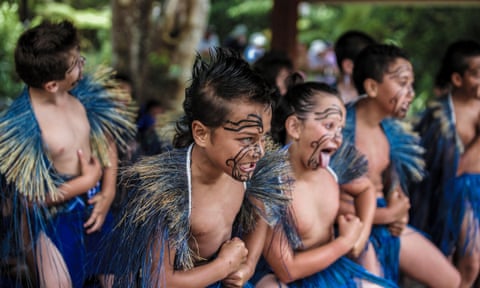Max Smitheram, 54, has attempted to learn te reo Māori (the Māori language) on numerous occasions, but he has never stuck with it – until now. A pakeha [European New Zealander], Smitheram attends free weekly classes and practises at home with his Uruguayan partner, who is also learning the language.
“I had a longstanding wish to learn Māori. It is really interesting to have the opportunity to understand different ways of thinking and understand more about my home,” said Smitheram, an environmental planner. “It is an important part of the heritage and identity of New Zealand.”
Smitherham is not alone. Te reo is undergoing a revival in New Zealand, with jam-packed classes and waiting lists now common. Māori language teachers from Auckland in the North Island to Dunedin and Invercargill in the South say they are unable to meet demand for their services and free classes routinely draw hundreds of students.
John McCaffery, a language expert at the University of Auckland school of education, says the language is thriving, with other indigenous peoples travelling to New Zealand to learn how Māori has made such a striking comeback. “It has been really dramatic, the past three years in particular, Māori has gone mainstream,” he said. “What we’re seeing is a clear indication that the language’s status and prestige has risen dramatically and research shows that is one of the key indicators of whether children and young people will be interested and committed to learning it.”
According to Statistics New Zealand, the proportion of Māori people able to hold an everyday conversation in te reo decreased 3.7% between 1996 and 2013. But anecdotal evidence suggests numbers of non-Māori speakers of the language are rising, as are young Māori adults and professionals, who would not have been captured in the last census.
Big business is on board, too. Google has launched a Māori version of its website, Vodafone has helped Google Maps record more accurate Māori pronunciations, Disney has released a Māori version of the hit Polynesian film Moana, and Fletcher Building has rolled out bilingual signs on all its construction sites.
“There’s an increasing sense that te reo is good for identifying your business as committed to New Zealand,” said Ngahiwi Apanui, chief executive of the Māori Language Commission. McCaffery echoed his point, saying more than a third of Māori teaching graduates were snapped up by big business keen to build stronger relationships with Māori and tribal groups with significant financial portfolios.

The status of te reo as an increasingly admired language – with its speakers garnering respect – is a long way from the period following the second world war when Māori speakers were chastised for using their language. Young Māori recall being beaten or whipped for speaking te reo in schools and government institutions such as orphanages, and at home more Māori gave up on the language and learned English to get jobs as a vast migration from rural to urban began. By the 1980s, fewer than 20% of Māori spoke te reo.
Now it is very different. According to surveys by Te Puni Kōkiri, a Māori public policy group, “attitudes towards the Māori language among Māori and non-Māori are improving”, and “the Māori language currently enjoys a high status in Māori society and also positive acceptance by the majority of non-Māori New Zealanders.”
Maori words such as kia ora (hello), Aotearoa (New Zealand), kia kaha (be strong) and kai (food) have long been part of New Zealand English. But the use of others is spreading. The prime minister, Jacinda Ardern, recently gave her child a Māori middle name: Te Aroha, Aroha meaning “love”. The gesture was welcomed by tribal groups, who said Ardern was improving relations between the government and Māori people and also sharpening her own language skills.
On New Zealand’s national day, Waitangi, this year, the first 49 seconds of Ardern’s speech on the sacred treaty grounds were delivered in te reo, while former prime minister Bill English spoke te reo for five minutes. Current Labour ministers Nanaia Mahuta and Peeni Henare are fluent speakers while the Green party co-leader, Marama Davidson, learnt as an adult.
At Buckingham Palace in April, the prime minister began her Commonwealth toast with a Māori proverb, in a video that has been watched tens of thousands of times.
In June, the Māori heavy-metal band Alien Weaponry’s album Tū went right to number one in New Zealand and has had more than a million streams on Spotify, while last year Wairua by the Māori group Maimoa Music was the most-watched YouTube clip in New Zealand, seen more than 5.5m times. In 2016 the Māori pop song Maimoatia shot straight to the top of the iTunes chart in New Zealand, knocking Justin Timberlake off the number one position. Producer Marama Gardiner, a fluent te reo speaker, said the song was designed to build confidence in young speakers of te reo, who could sometimes feel shy practising their language skills. “I want people to be singing a great te reo song all over the world. That would be such a boost of confidence for speakers in New Zealand, that their indigenous language is not dying but adapting.”
A larger range of Māori programming has also played a significant role in normalising the language, including publicly funded Māori TV, whose presenters and journalists speak only in Māori, with captions provided.
All signage is now bilingual in government offices, hospitals and most public spaces and the first bilingual children’s playground was opened in Rotorua this year.
Mainstream broadcasters on commercial channels such as TVNZ and TV3 have shown a commitment to using Māori live on air and ignore critics who complain of feeling excluded.

Television news presenter Kanoa Lloyd, of Māori descent, began introducing te reo words to her weather reports in 2015 and received a torrent of complaints and online abuse. She has continued to use te reo on her prime-time show The Project. The governor-general, Dame Patsy Reddy, revealed this year that she had started learning te reo, but said she was concerned about the shortage of Māori teachers nationwide.
Last week the Labour minister Kelvin Davis held a hui [meeting] with Māori language experts, seeking their advice on how to get more New Zealand teachers speaking the language, so they could teach eager students. Davis is himself a conversational Māori speaker. “We want them to have the confidence and competence to be able to weave te reo into their lessons, [and] to normalise te reo in the classroom,” he said.
“We want all New Zealanders to feel that te reo is just a normal part of our lives and that we can switch in and out of languages as we see fit.”
Māori language experts say the language has never been more widely used, normalised or respected. The dark days, they say, of Māori speakers being beaten and punished are long gone.
“I think there is increasing awareness that there is intrinsic value in learning te reo, that it is the language of this country,” said Dr Arapera Bella Ngaha, who is studying the revitalisation of te reo at Auckland university. She relearned te reo as an adult after she was banned from using it at boarding school. “It has become cool and I am very happy about that. For a long time we thought it was over.”
